More than 10,000 years ago, the unique landscape of County Offaly, was sculpted by the awesome natural forces of the dying Ice Age. As the glaciers retreated, they left, in their wake, narrow ridges of sand and gravel which were deposited by the streams of water that had once flowed in tunnels beneath the melting ice. These ridges now comprise the Esker Riada, from which Esker Hills Golf Club gets its name.
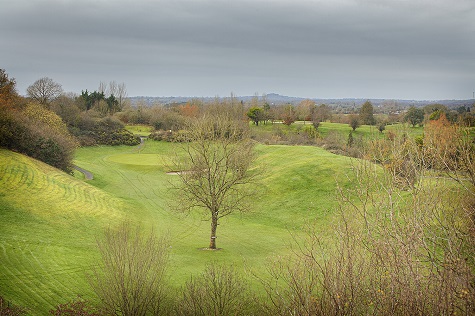
Hills and valleys, formed by the retreating ice from the ice age, are the main features at Esker Hills as can be seen on the 8th hole
Esker Hills Golf Club is owned by the O’Brien and Mollow family. The course was designed by Christy O'Connor Junior. Construction of the 18 hole golf course, with USGA specification greens, began in 1994. With minimum soil disturbance, a wonderful course through Mother Nature's own sand hills and sweeping valleys was created. It opened for play the following year.
One big claim to fame that Esker Hills has is that PGA Tour golfer and 2019 Open Champion, Shane Lowry started his golf here. His father Brendan organises junior golf at the club and what a proud father he must have been when Shane won the 2009 Irish Open at Co. Louth as an amateur and ten years later winning the 2019 British Open. The club is also so proud of Shane’s achievements. Shane never forgot his roots and is a regular visitor to the club, in between his busy tour schedule. He is a great supporter of junior golf. The club can even boast having a former Irish Prime Minister, Brian Cowen, as one of its members.
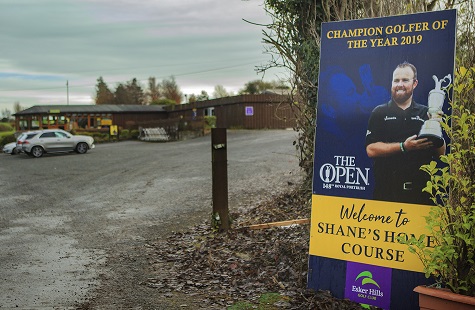
Esker Hills Golf Club is the home club of professional golfer and 2019 Open Champion Shane Lowry
Esker Hills Golf Club has around three hundred members but it is mainly a pay and play course.
The Course Superintendent at Esker Hills is Willie Allen. He came to the club in 1999, having previously spent fifteen years maintaining the course at nearby Moate Golf Club. Back then, the greens at Esker Hills were bent/fescue, with some poa annua thrown in for good measure.
With every successful course comes a successful team. There are four full time staff working on the course. Tom Naughton, Valdis Grikovs and Janis Grikovs work with Willie and have many years of experience between them.
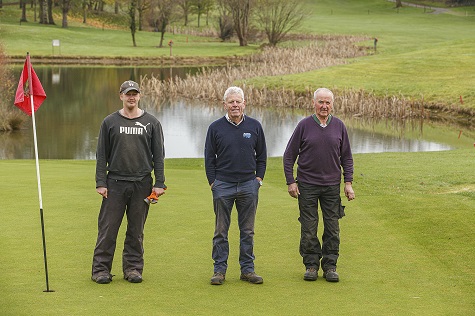
Meet the greenstaff. From left: Janis Grikovs, Willie Allen, Tom Naughton. Missing from the photo is Validis Grikovs
One thing that favours Esker Hills is the free draining soil lying underneath the entire course. In fact, it is more sand and gravel than soil and, because of this, members from clubs, both far and near, head for the course during wet weather, particularly in winter. Ground conditions are so favourable that even golf buggies are allowed on the course throughout the entire year.
But the real jewel in the crown is not the free draining course, but the revolution that has taken place on the greens. I first visited Esker Hills Golf Club seven years ago, soon after Willie began transforming his greens from a poa annua to a fescue sward. What he achieved back then was remarkable. It was the talk of the town. I wondered, seven years later, was this still the case? Was it all a quick success and had the greens reverted back to the old annual meadow grass sward? I decided to revisit Esker Hills to find out for myself and see how Willie had progressed (or not).
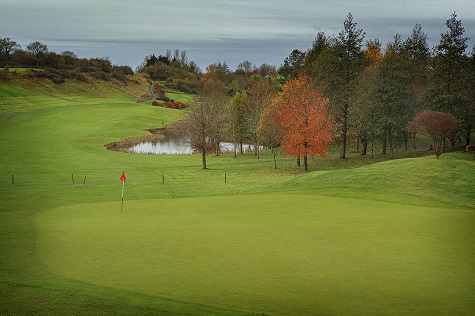
The 7th hole
I was amazed at what I saw and what Willie has achieved and the way he has done it. He has broken almost every rule in the book of agronomy. He doesn’t hollow core; doesn’t use wetting agents or fungicides and only scarifies once every two years. Willie has indeed transformed the greens from a poa sward into an almost 100% fescue surface. How is this possible using only bare minimum greenkeeping principals? Willie holds back no secrets on his success.
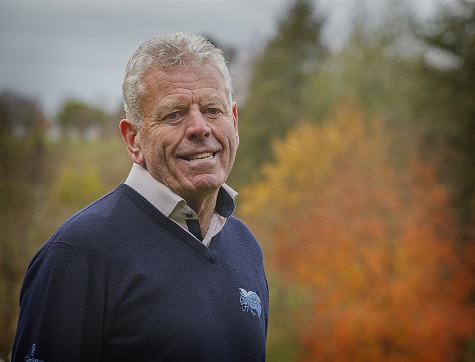
Head greenkeeper, Willie Allen
"Our course maintenance budget is relatively modest and most of the costs went into looking after the greens with fertiliser, fungicides and sand. I wanted to create a more sustainable sward that took into consideration the modest budget and the economic times, whilst providing a surface for the golfers that was smooth, true, firm and consistent. Poa Annua was just too labour intensive and, having this natural site of sand/gravel, I put it to the management and members, 'would they back the creation of an inland links with real links-style fescue dominated greens'?"
"I explained the key advantages and what discomfort there might be, but the wish to have consistent, true and smooth greens was a prize the members and management jumped at and gave their full support.

The beautiful 10th hole
"I invested heavily in seed and started overseeding the greens with fescue in April of that year (2010), using a dimple seeder. I managed my fertiliser programme carefully and concentrated on overseeding and more overseeding."
Willie's task wasn't easy at first. With restrictions on fertiliser, the poa started to look hungry and became susceptible to disease. But he was persistent. Wherever bare areas developed, grass seed was sown, and it was not long before young fescue shoots began to appear. The fescue started thriving and now, after eleven years, Willie has a sward of turf on his greens that is the envy of many. He is very proud of what he has achieved. You can hear it in his voice. Even today, eleven years into the programme, he is still as passionate as ever about fescue greens. The feedback from fellow greenkeepers all over Ireland is incredible. Many greenkeepers are coming to see for themselves what he has done. He also has had greenkeepers visiting him from America, the UK and Germany.
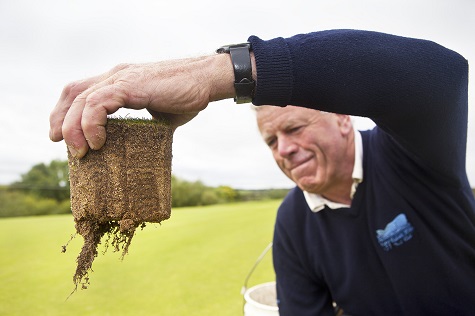
Willie is proud to show the long root development of his fescue greens
The grass gets hardly any disease now. In fact, Willie has not sprayed fungicide since December 2012. His nitrogen inputs are now reduced to between 32-36 units/hectare (from a high of 150 units in 2007). His annual phosphorous and potassium applications have also been reduced. They are now down to 11 units and 48 units respectively, from a high of 50 units and 240 units. Willie often seeks the advice of his colleague, Fintan Brennan of Portmarnock Golf Links, a man who knows all about fescue.
Willie's nutritional programme consists of applying a granular fertiliser in spring (TX910) and again in autumn (T-Plex3:0:6), with liquid seaweed in between. He believes in some of the old greenkeeping practices - such as diluting sulphate of iron and applying it on the greens and surrounds in autumn - to harden up the grass before the onset of winter.
It has been ten years since he last hollow cored the greens. Instead, he solid tines with 8mm pencil tines each spring and autumn, along with an application of around 60 - 70 tonnes of sand over the eighteen greens (which includes the aprons and approaches). When sand is applied, he follows this up with overseeding. When this happens he doesn’t collect the grass for at least two weeks. No sand is applied during the summer. Greens slitting is carried out only in December.
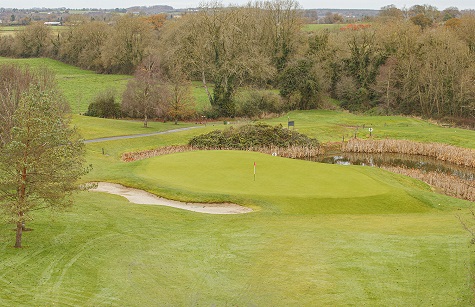
The 5th green (par 3) as seen from the elevated tee box
Willie has seen huge benefits with the changeover. Because fescue is a fine leaf grass, it is possible to mow at higher heights without losing green speed. It’s hard to believe that he only mows the greens three or four times a week in summer. The height of cut is 5mm in summer going to an amazing 7mm in winter. When I visited Willie on a cold December morning, he showed me how fast the greens were. I couldn’t believe it when he told me that the greens had not been mowed for over a week and the height of the sward was 7mm. Only in dry weather does Willie use a greens iron, which helps in keeping the green speed up. With such a high height of cut, he can still manage to get a reading of 11 on the stimpmeter. It almost defies logic.
Another benefit he has seen is how little water is needed in the summer. "I only turned on the sprinklers for one night last summer. Every other time, one of my staff goes around with a hand hose and just waters the local dry areas," says Willie. “I don’t use wetting agents anymore”.
He has not sprayed wetting agent on the greens for almost ten years. The result of using no fungicides and wetting agents, with better fertiliser regimes, can be seen on the greens, and it has made a big saving on the annual course maintenance budget, a saving of €10,000 (£9,000) every year.
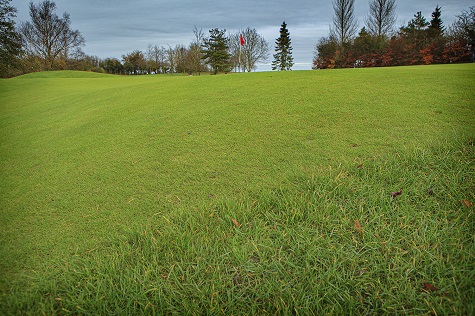
This photo shows one of the approaches covered in fine fescue as the rough in the foreground is predominantly a perennial ryegrass sward
Not happy with his lot, Willie also wanted to enlarge the greens. He mowed out into the aprons, at greens mowing height, where a lot of perennial ryegrass was growing, and managed to rid the collars of a lot of the rye with the help of the overseeding. Spraying the ryegrass with herbecide in the autumn helps to eliminate the remaining ryegrass and he is continually mowing out further into the surrounds, killing off the ryegrass and weeds as he does so.
One disadvantage of making the greens bigger was that the sprinkler heads, which used to be situated at the edge of the green, ended up on the putting surface, some by as much as one metre in. These had to be relocated out further to the new edges of the greens.
"I would like to see a situation where the golfer is putting many yards away from the green instead of chipping - just like you see on links courses”, said Willie.
In just four years, Willie has transformed the greens at Esker Hills without a sod being turned over. This method of greens transformation has got great support from the members. The owners of the club also supported him throughout the transformation years. His boss, Donal Molloy, was so impressed with what Willie and his staff have achieved that he got an article put in the local newspaper. Even Shane Lowry gave him compliments.
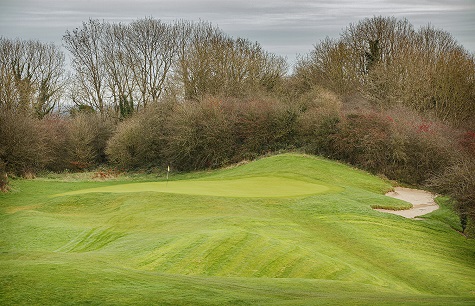
The 13th hole
But, like all medical treatments, there comes a health warning. At times during the transformation, the putting surfaces were poor and the greens looked terrible. “What works at Esker Hills may not work on other golf courses”, warns Willie. A sand and gravel soil structure, along with well constructed sand greens, has contributed a lot to the success of transforming the greens, along with great knowledge and experience from Willie. He plans to extend this treatment to the tees next Spring.
I left Esker Hills with great admiration for Willie and his team. The quality of the greens and approaches is breathtaking. So much so that it has been instrumental in attracting new members and has seen a surge in visitor numbers. You will have to visit Esker Hills to see the greens revolution for yourself.